If you’ve taught Pre-K, Kindergarten, or first grade, you’re probably very familiar with patterned texts. You know, the level AA or level A books where the same sentence or phrase is repeated on each page, like this one:

These books can be valuable for emergent readers (students who are just beginning to learn how to read). To be able to read one of them, a child doesn’t even need to have mastered all her letter sounds. If you help her read the pattern (the words that repeat), she can use picture clues to “read” many of the other words in the text.
For example, on the page below, the picture clearly shows a child reading. If the child already knows that the rest of the words say “I like to,” she can use the picture to figure out that the “additional” word says “read.”
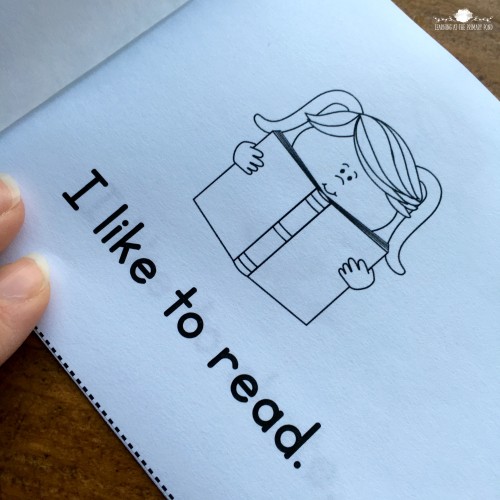
On other pages, the picture may not immediately give away the unfamiliar word. In the example below, the child would probably have to use the first letter (h) and look at the picture to read the word “hug.”
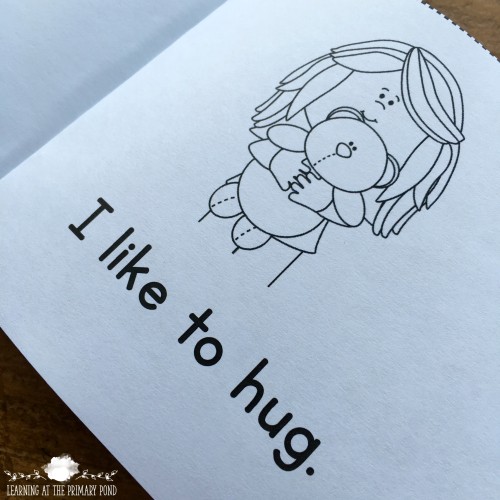
Having to use the first letter and the picture is the “work” in the book – the place where the child is challenged to apply her learning to do some “real” reading.
And as you can probably guess, there really isn’t all that much “work” in a Level A text – just a couple of places where the child really has to use her letter sound knowledge and/or sight word knowledge to read the words.
The simplicity of patterned texts is useful because it:
- Allows students to practice concepts about print, like pointing one-to-one and reading left to right
- Helps beginning readers develop confidence and start to view themselves as readers
- Allows students to practice their developing knowledge of letter sounds, sight words, and reading strategies
However. There is a “but” to all this.
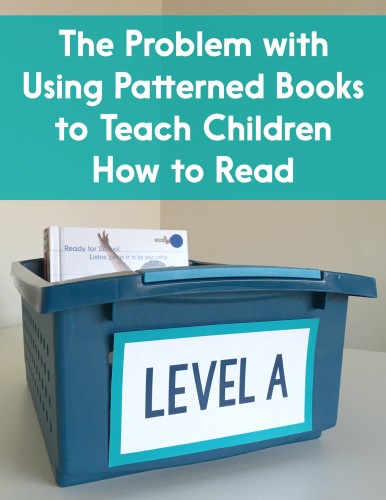
Patterned texts can be very misleading to students. If students spend months reading Level A text, many begin to believe that this is what reading is – guessing at the words, relying heavily on the pictures, and repeating the same sentence on each page. And that, of course, is not what reading is really all about.
Patterned texts are particularly problematic for students with either a) weak oral language skills or b) very strong oral language skills.
Students with weak oral language skills (or English Language Learners) often have a difficult time reading these patterned texts, regardless of how much letter sound knowledge they have. The premise of these texts is that students will be able to “read” many of the words simply by looking at the picture. But if a child sees a picture of “cherries” and does not know what they are called, she is not going to be able to read the word “cherries.” Nor is she going to be able to decode the word. Even though this is a beginning level text, the word “cherries” starts with a digraph (ch) and has a long vowel sound at the end, spelled by “ie.” If a child is reading at Level A, she is not going to have mastered these two spelling patterns yet.
In addition, students with poor oral language skills or ELLs may struggle to “pick up” the pattern of the book. Even if the teacher tells them the pattern, they may forget it as they go through the book because the structure is not familiar to them. And since only some of these words will be decodable, students can’t access those words if they don’t remember the pattern. For these students, a text that is supposed to be relatively easy becomes full of challenges that are out of reach.
On the other hand, students with very strong oral language skills may read those beginning texts with 100% accuracy by relying too heavily upon their strong vocabularies. When a student knows immediately that the fruit in the picture is called a “raspberry,” there’s no need for him to use any letter sound knowledge. In addition, these students easily pick up the pattern of the book. Their strong oral language skills make remembering and repeating the pattern a cinch.
In turn, this may give us, their teachers, the incorrect impression that these students are stronger in their letter sound knowledge and decoding skills than they really are. And again, reading these types of texts for too long may cause these students to develop a skewed concept of what it means to read.
Although patterned texts present challenges, you don’t need to go dump your Level A books in the teacher’s lounge with a sign that says “FREE.” 😉 I mean, I write patterned books – on TpT and through a publishing company.
We just need to be aware of the challenges that these books present, and take steps to ensure that students don’t get “stuck” in texts that do not require much “real” reading. Here are some things that you can do to move students beyond patterned texts:
- Gradually decrease the amount of support you provide in helping students read the pattern. When I start children in Level AA/A patterned texts, I generally “give” them the pattern. I tell them exactly what the repeating phrase is on each page, and I show them how to read it. After a couple of weeks, I mention the pattern a couple of times during our pre-reading conversation, but I no longer read the words on the page for them. (Example: We are reading a book called Shapes that has the pattern “I see a ____.” Before I give the children their books, I say, “Let’s look at the cover. I see a star. What do you see, Jenny?” and then prompt Jenny to use the phrase “I see a ____” to respond. In this case, I’m not showing students the actual text that says “I see,” but I’m putting the language “in their mouths” so that they are able to access the pattern.) Eventually, I don’t tell them what the pattern is at all – although I may point out any super tricky words. Students then have to use their decoding skills to figure out more of the words than if I had outright given them the pattern.
- Play “Cover Up The Picture.” Once a child or group of students has read a patterned book, explain that now you are going to cover up some of the pictures. Their job is to figure out what the page says, even without the picture clue. You can either fold back the page (if the words and text are on different pages) or use a sticky note to prevent the children from seeing the picture. Have them read the pattern and then use the first few letters of the word. This forces students to focus on the print, rather than relying solely upon the picture. And my intervention students think that this is the BEST “game” ever!
- Use more phonics texts / decodable readers. Decodable readers are different from leveled books. They “force” kids to use their phonics knowledge, because the words cannot be guessed entirely from the pictures. While I’m not a huge fan of decodable books that are nonsensical or lack meaning, A) there are some great decodable texts out there, and B) they can be incredibly powerful in helping kids learn what reading is all about.
- Put students in Level B books even if the data does not indicate that they are “ready” yet. For the most part, I wait until students can read a text with 95% accuracy or above before moving them up to the next level. However, I don’t abide by this “rule” when moving students from Level A to Level B texts. If a student has been reading Level A (patterned) texts for a couple of months, then it’s time to move on. I pull out a Level B text (which typically has less of a pattern) and figure out what supports I need to put in place in order to help her be successful with the book. Do I need to pre-teach vocabulary? Perhaps go over a phonics pattern before starting? Do an echo read first? I’ve found that if I choose the correct scaffolds, a child can read a Level B text even if she is not always reading Level A texts with high accuracy. You can also alternate Level A and Level B texts, a strategy used by Fountas’ and Pinnell’s Leveled Literacy Intervention program.
If you need Leveled Readers, check out the sets in my TPT store. They are available in print, digital, or a print and digital combination to meet your current needs. Each set includes 5 books and accompanying lesson plans!
The lesson plans are ready-to-teach and include suggestions for a book introduction, comprehension questions, strategy instruction, and follow-up activities for phonological awareness, phonics, high frequency words, etc.
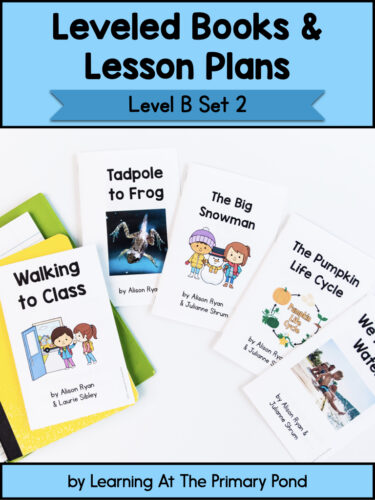
Do you have any strategies for helping students “make the jump” out of patterned books? Or do you have any students currently “stuck” in Level A? Please comment below – I’d love to hear from you!


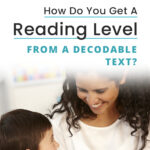
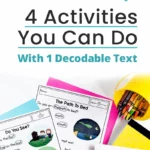
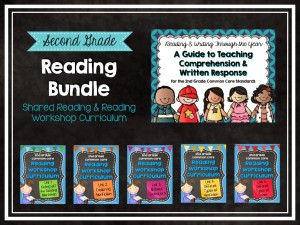
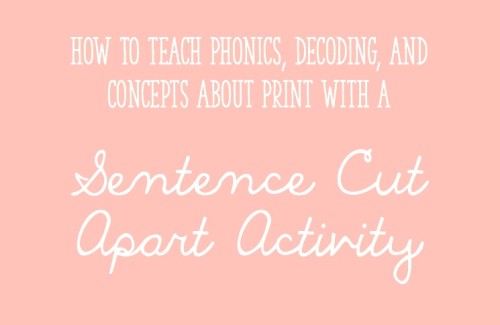






Alison, this is such a timely post for me to read. I have been using some patterned texts with my daughter who is 4.5 and wanting to read, but was internally having some debates because she is also learning letter sounds and these A levelled books, but patterned, don’t follow the sequence of sounds we are learning. I’ve never really given the readers a whole lot of thought, but now see why we should! The tension between wanting children to see themselves as readers as early as possible (facilitated by patterned texts) and using the alphabetic principle to read (decodable)… Read more »
Hey Erin! Some books labeled as Level B are not super decodable, while others are a bit more do-able. It varies from book to book, but generally speaking the F&P leveling isn’t really used with decodable books.
It really is a hard balance!
Alison
Not boring at all! Your thoughts are so helpful to me. I am brand new to working in a literacy intervention setting and am learning so much from your blogs. I am trying to figure out what kinds of books to use with my small groups of kindergarten students and this post addressed the exact question I was asking myself about what types of goals are met by introducing various types of ‘easy readers’ to my students who do not yet know their letters.
I’m so glad it was helpful! 🙂 It can be tricky to figure out what types of books are best!
I am fascinated with this post, because I see patterned books as potentially problematic also. I, too, write patterned books on TpT and through a traditional publisher (the Handprints series) and taught Reading Recovery for 10 years. What I do with my students (and the books I have written) is quickly move students into books that have minor changes in the text patterns. That way they don’t fall into the habit of thinking of reading as memorizing and picture-identification. They learn to self monitor visually. Thank you for this thought-provoking post.
Yes, I couldn’t agree with you more, Ann! Thank you for sharing your thoughts! 🙂